![]()
![]()
T H E A L L - A R M E N I A N P O E T

WRITTEN BY PROF. LEWON HAXVERDEAN,
DOCTOR OF PHILOLOGICAL SCIENCES
Tumanian is a reflection of Armenia, reflecting her landscapes, customs and popular legends, her grieves, joys, ideals and dreams.
Hovhannes Tumanian, one of the greatest Armenian poets, is a writer of universal appeal. His works with their classic simplicity and depth are intelligible to people of every age, nationality and time.
There are writers, and famous ones at that, who are not a man's lifelong companions, but only accompany him along a certain stretch of life's road, be it childhood, youth or maturity. But there are also writers that belong to all ages, from early childhood to venerable old age.

T‛ U M A N
I A N -- T H E A L L A R M E
N I A N P O E T
Hovhannes Tumanian is one of these.
The Armenian reader finds it as difficult to recollect his first meeting with Tumanian, as his early infancy. He first heard him on him mother's knee, then as soon as he had learned his ABC, read him himself and gradually entered Tumanian's poetic world.
The poet wants the infant emerging into daylight to see life as bright and cloudless as joy itself. He approaches the child as a kindly spirit, to tell him about birds and foxes, dogs and cats, trees and flowers, to lead him along the wonderful paths of early knowledge.
![]()
"Spring cam merry, the birds returned,
The sun rose warm, waters gurgled,
Days of plowing and sowing came.
I turned ravens into a team,
And harnessed geese as a spare one,
I hired sparrows to watch the herd,
And partridges to bake the bread,
I had a plot. I plowed and tilled,
I sowed barley and rye and wheat."
(The Little Land-tiller)

S I A M A N T‛ O --
THE GREAT ROMANTIC POET ONE OF THE HUNDREDS OF
INTELLECTUALS KILLED BY 'THE SPECIAL ORGANIZATION' DURING THE GENOCIDE.
When he gets a little older, the junior member of society learns from the poet that the affairs of this world are not so cloudless, after all, that there are good and evil forces in the world, and a constant struggle goes on between them, and that in their eternal strife good does not always triumph. The juvenile reader now takes up "A Drop of Honey," a legend (based on a medieval Armenian fable) telling how a destructive war breaks out all because of a drop of honey, and how at the end of it the survivors -
"Asked each other terror-stricken,
Where the world-wide great disaster
Took its origin, its sources."
The youth also reads "My Friend Nesso," a story about how the best and handsomest boy in the village turns into a bad, dishonest man, dragged to the bottom by life's deprivations.

THE INSANITY OF THE GENOCIDE...KOMITAS VARTAPET BECAME
INSANE
AFTER PERSONALLY
WITNESSING SOME OF THE MOST DISTURBING
SCENES OF INDESCRIBABLE CARNAGE
DURING THE GENOCIDE. INNOCENT CIVILIANS -- OLD MEN, WOMEN AND
CHILDREN
WERE MERCILESSLY SLAUGHTERED BY THE TURKISH DEATH SQUADS.

SHUSHANIK KURGHINIAN (1876-1927). A REVOLUTIONARY
POET, A SOCIALIST WHO WROTE INSPIRING POETRY
ABOUT THE DOWNTRODDEN MEMBERS OF THE SOCIETY,
MOST NOTABLY DEDICATING HER LIFE AS A TRUE SOCIALIST
TO THE FIGHT FOR EQUAL RIGHTS FOR ALL.
The youthful reader will probably derive the greatest benefit from Tumanian's masterpieces "In the Armenian Mountains," "Armenian Grief" and "With My Fatherland," poems which set the course for future Armenian patriotic poetry. Then come the stories "The Bet", "The Construction of the Railway" and "The Deer." Next follow the great poetic canvases: "David of Sassoun", a brilliant rendition of the superb epic of the Armenian nation; "Parvana," depicting the eternal yearnings of unquenchable love; "The Poet and the Muse," on the subject of the contradiction between the lofty ideals of poetry and harsh reality; "Sako from Lori" showing the destructive force of prejudice; "The Capture of Fort Temuk" which traces the criminal path leading from ambition to treason, and, finally, "Anush" rightly considered Tumanian's masterpiece.

MANY LEADING ARMENIAN INTELLECTUALS, WRITERS, ARTISTS AND POETS
OF XIXTH
AND EARLY XXTH CENTURIES LIKE VARUZHAN, SIAMANTO, TERIAN, TUMANIAN,
CHARENTS AND COUNTLESS OTHERS WERE DEEPLY IMMERSED IN THE STUDY OF
PRIMORDIAL ARMANI HERITAGE WITHIN BROADER STUDY OF
THE ESOTERIC PHILOSOPHY OF BOTH EASTERN AND
WESTERN WISDOM TRADITIONS. 1919 PAINTING BY MARTIROS SARIAN
SHOWING SYMBOLIST ART OF HIS OWN ANIMUS OF THE TIME.
GOLD FIGURINE OF GODDESS A Y A [ETERNAL FEMININE BEGINNING/WISDOM],
RED POMEGRANATES [LIFE/FERTILITY]. SPHINX, BLACK & WHITE CANINE [SIRIUS],
WHITE HORSE, BLACK ELEPHANT. MANDALA WITH SUBLIME BUDDHIST SYMBOLISM
WITH THE 12-SPOKE COSMIC FIERY RED WHEEL LEADING TO THE CENTER
THAT HAS THE UNFOLDED LOTUS/ROSE AND THE CROSS OVER PASTILLE
VIOLET/GREEN BACKGROUND.
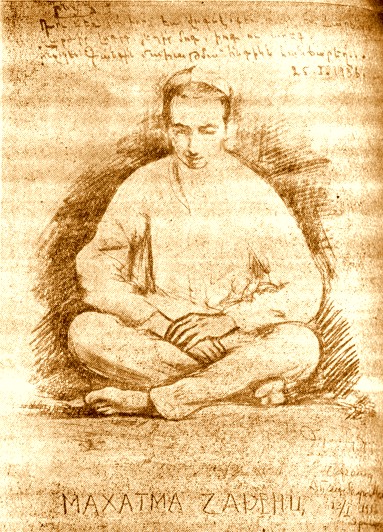
SKETCH OF CHARENTS DURING MEDITATION BY BAZHBEUK MELIKEAN. 1936.
In this poem the author expresses his philosophy of life, his personal ideas about man's existence, environment and the world of the human passions. The poet's nostalgia and his irrepressible love for his native land is revealed here:

"My longing for that wondrous land
Again and again it calls me back,
And my soul on wings outspread
Flies straight home where before the fire
In my native hearth they are all awaiting
Waiting anxiously for me…."
This poem, like every romance, has a tragic ending, and the poet, turning to Anush, roaming in solitude and despair at the loss of her lover, addresses her with words on the eternity of life and infinite renewal.

"O fair lady, why do you cry
So distraught and lonely?
Why do you cry and wander
In these valleys every day?
If you desire fragrant roses,
Wait for a while and May will come;
But if you long for your lover,
Know, he is gone, lost forever….
Neither crying nor wailing
Will return your beloved;
Why then in vain extinguish
The youthful fire of your eyes?
Pour cold water from fountain
On his lone and sorrowful tomb;
Go and begin another love,
That is the way of the world."
***
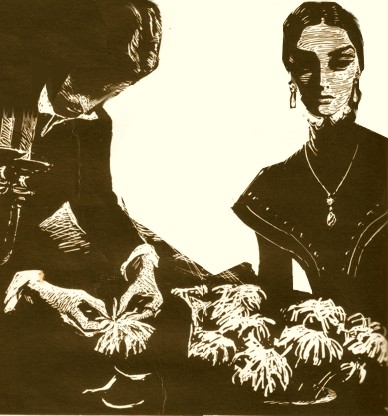
Tumanian's works are a living phenomenon in constant motion, a whole world,
swarming with countless heroes and buzzing with the sound of human voices. There
is something we must know about Tumanian if we want to understand that world.
Everything he wrote, prose and poetry, fairytales and realistic stories, even
his journalistic writings and correspondence, has an inner unity, embraced as
they are by the coherent world outlook of this great individual. Hence the
extraordinary unity of his art, for all its great variety and wealth of tones
and shades, a unity that is peculiar only to great artists.
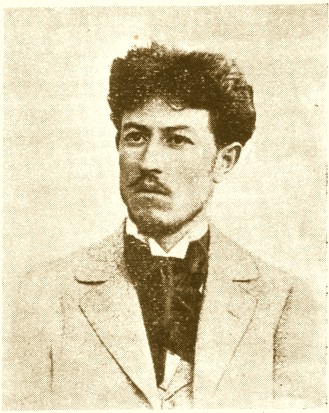
A. A D A L I A
N
THE GREAT ARMENIAN ROMANTIC WRITER OF THE XIXTH CENTURY
Hovhannes Tumanian was born on the 19th February, 1869, in the town of Dsegh of the Lori Province, in the very spiritual family of Holy father, Ter-Tadevos. Lori, or as Ancient Armenians called it, the land of Gugars, was described by renowned Armenian poet Avetik Isahakian as a county of tales and legends, every corner of it a testament, each stone a witness to the heroic past. The poet spent his childhood in Lori, and that Homeric land left its indelible imprint on all his works.
Toumanian went to primary school in his native village. He was then a pupil at the Nersessian School in Tiflis, which he left early, leaving his future education and development to his own efforts according to his tastes and preferences. That is why the famous Russian poet Valeri Bryssov could describe Toumanian as "largely self-educated, and an extremely well-read man if not systematically so," "in whom genius, are astonishingly synthesized."
The rest of Toumanian's life, until his death in 1923, was passed in Tiflis, which up to the revolution was the administrative centre of Transcaucasia, and a great centre of Armenian culture.
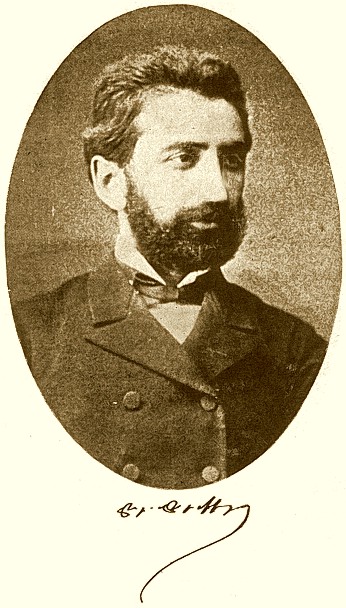
A R P I A R A R P I A R I A N. THE POPULAR
XIXTH CENTURY ARMENIAN WRITER
WHO SET UP PRINTING HOUSES THAT PUBLISHED NUMEROUS LITERARY
WORKS OF THE CONTEMPORARY WRITERS OF THE ROMANTIC ERA.
He did not travel far, as did his younger friend Avetik Isahakian. His trips were rare and only made when unavoidable. He once made a journey to St. Petersburg and Moscow, but that was a trip in a prison carriage in 1908, taking the poet to trial in court, accused of anti-tsarist activities. Towards the end of his life, in 1921, he traveled again; this time to Constantinople in connection with the work of the Armenian Relief Committee and returned with his health undermined. Lastly, towards the end of 1922, Toumanian, already seriously ill, was taken to Moscow for medical treatment, and after a number of unsuccessful operations and attempt to try to cure his ever growing ailment, the great Armenian poet, Hovhannes Tumanian passed away in one of the cold Moscow hospitals. His remains were moved to Tiflis.
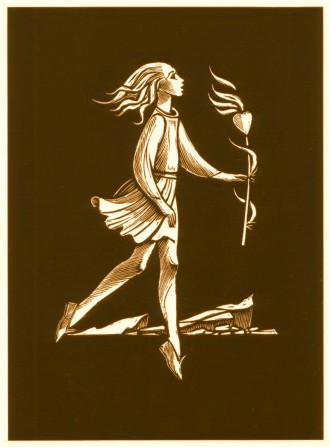
If, despite the absence of salient events in Tumanian's own biography, he nevertheless lived a highly intense life, more so than any other Armenian poet, at least during that turbulent period, the reason must be sought in the environment in which he lived. Toumanian lived at a turbulent period in Armenian history. No other period in the long chronicle of the Armenian nation is so dramatic, condenses so many splendid hopes and illusions and so much shattering disillusionment and tragedy as the end of the Nineteenth and the first two decades of the twentieth centuries brought upon the Armenian nation.
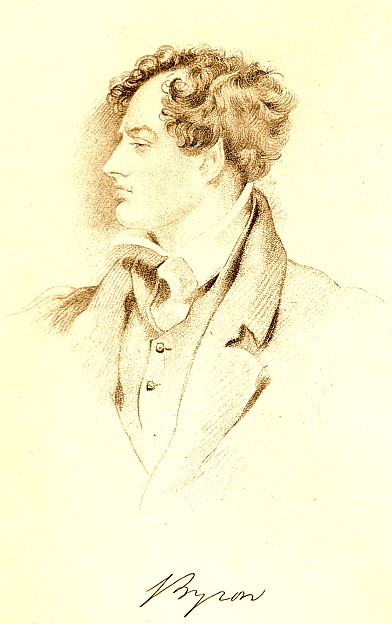
LORD GEORGE GORDON BYRON. THE OUTSTANDING EARLY XIXTH
CENTURY POET
IDEALIST -- A GREAT FRIEND AND DEFENDER OF THE ARMENIAN PEOPLE AN
'HONORARY ARMENOLOGIST' WHO STUDIED ARMENIAN LANGUAGE AND CULTURE IN
THE WORLD FAMOUS SAN LAZARRO ARMENIAN NATIONAL ACADEMY OF SCIENCES
WITH THE MEKHITARIST FATHERS. HE WAS MORTALLY WOUNDED WHILE FIGHTING
THE TURKISH HORDES IN THE GREEK WAR OF INDEPENDENCE
Tumanian was an eyewitness and participant of all these cataclysms. He devoted his life to a country that had many enemies and few friends.
Tumanian engaged in numerous public activities. In the autumn of 1912 he sponsored the Caucasian Society of Armenian Writers in Tiflis and was chairman of the society up to the fading of his health in 1921. The society organised weekly literary readings and public lectures devoted to Armenian, Georgian and other literatures.
In the three hundred odd publicistic articles he wrote, Tumanian showed himself to be an accomplished critic and historian of literature and expressed many interesting ides on literature, art, language and Armenian culture.
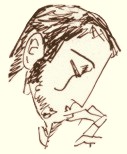
In 1917 - 1918 Tumanian sponsored a number of societies, Union of Countrymen's Associations, Society for Help to War Victims, Society for Help to Orphans and Refugees. His humanitarian activities consumed most of his time, efforts and energy during this period.
Toumanian saw the supreme goal of art to be the bringing together of men, peoples and nations. He considered Shakespeare to have succeeded best in this and wrote of him: "He brings all peoples closer together, both to the English nation and to one another. And herein, indeed, lies the magic power of poetry and art in general; safeguarding the fragrance and charm of each in uniting them all, and from the many create a harmonious whole."
We can proudly claim that Tumanian's entire work always has and always will serve that noble aim.
![]()